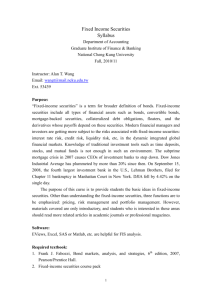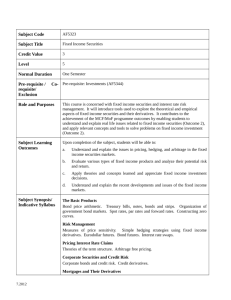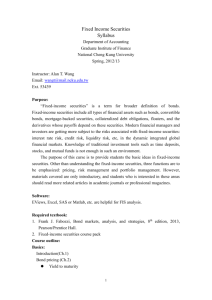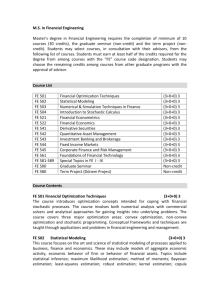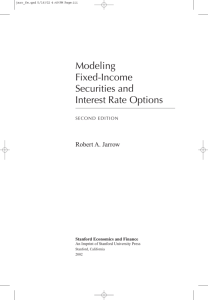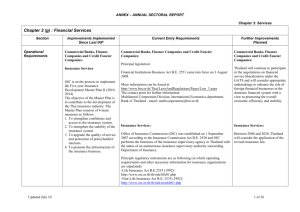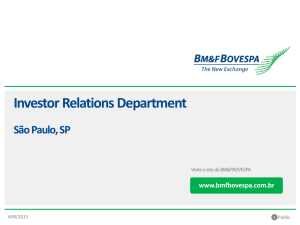UNIVERSITY OF ILLINOIS College of Business
advertisement
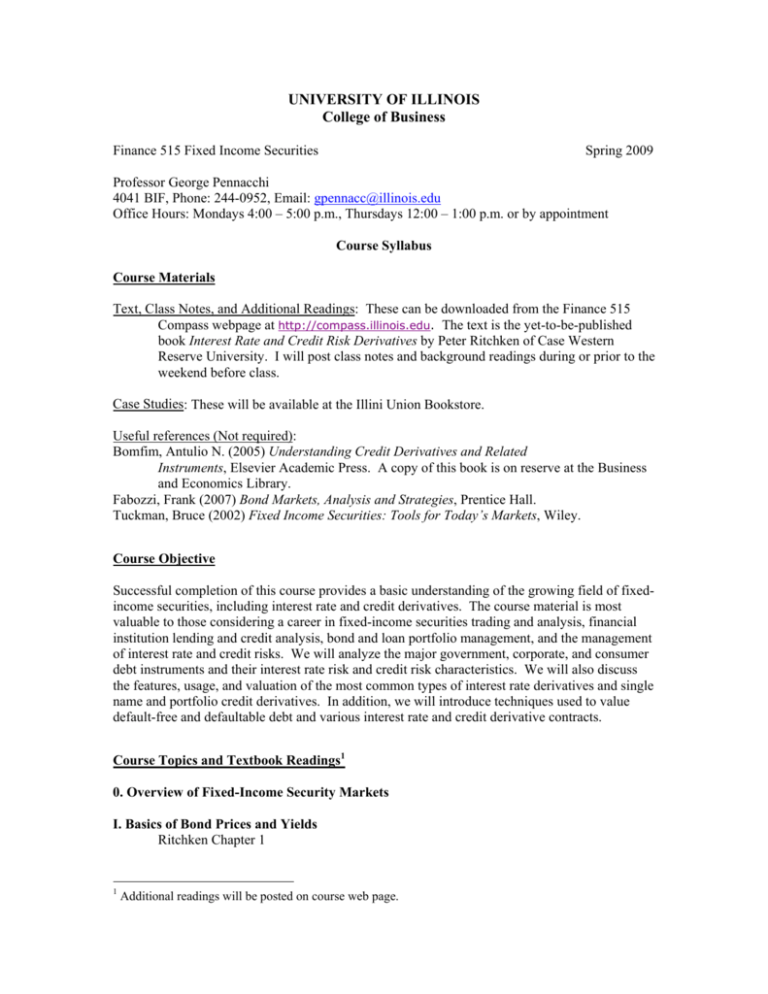
UNIVERSITY OF ILLINOIS College of Business Finance 515 Fixed Income Securities Spring 2009 Professor George Pennacchi 4041 BIF, Phone: 244-0952, Email: gpennacc@illinois.edu Office Hours: Mondays 4:00 – 5:00 p.m., Thursdays 12:00 – 1:00 p.m. or by appointment Course Syllabus Course Materials Text, Class Notes, and Additional Readings: These can be downloaded from the Finance 515 Compass webpage at http://compass.illinois.edu. The text is the yet-to-be-published book Interest Rate and Credit Risk Derivatives by Peter Ritchken of Case Western Reserve University. I will post class notes and background readings during or prior to the weekend before class. Case Studies: These will be available at the Illini Union Bookstore. Useful references (Not required): Bomfim, Antulio N. (2005) Understanding Credit Derivatives and Related Instruments, Elsevier Academic Press. A copy of this book is on reserve at the Business and Economics Library. Fabozzi, Frank (2007) Bond Markets, Analysis and Strategies, Prentice Hall. Tuckman, Bruce (2002) Fixed Income Securities: Tools for Today’s Markets, Wiley. Course Objective Successful completion of this course provides a basic understanding of the growing field of fixedincome securities, including interest rate and credit derivatives. The course material is most valuable to those considering a career in fixed-income securities trading and analysis, financial institution lending and credit analysis, bond and loan portfolio management, and the management of interest rate and credit risks. We will analyze the major government, corporate, and consumer debt instruments and their interest rate risk and credit risk characteristics. We will also discuss the features, usage, and valuation of the most common types of interest rate derivatives and single name and portfolio credit derivatives. In addition, we will introduce techniques used to value default-free and defaultable debt and various interest rate and credit derivative contracts. Course Topics and Textbook Readings1 0. Overview of Fixed-Income Security Markets I. Basics of Bond Prices and Yields Ritchken Chapter 1 1 Additional readings will be posted on course web page. 2 II. Treasury Securities and Money Market Instruments Ritchken Chapter 2 Case: Innovation at the Treasury: Treasury Inflation-Protection Securities III. The Federal Reserve and Government Security Markets Ritchken Chapter 3 Case: Salomon and the Treasury Securities Auction IV. The Term Structure of Spot, Forward, and Par Rates Ritchken Chapter 4 Ritchken Chapter 12 V. Repurchase Agreements and Forward Contracts Ritchken Chapter 5 Case: Arbitrage in the Government Bond Market? VI. Eurodollar Deposits, Floating Rate Bonds, and Forward Rate Agreements Ritchken Chapter 6 VII. Eurodollar Futures Ritchken Chapter 6 VIII. Interest Rate Swaps Ritchken Chapter 7 Case: Banc One: Asset and Liability Management IX. Constructing Zero-Coupon Yield Curves Ritchken Chapter 8 Case: Deutsche Bank: Finding Relative-Value Trades X. Measures of Price Sensitivity: Duration and Convexity Ritchken Chapter 9 Case: Ticonderoga: Inverse Floating Rate Bond XI. Key Rate Durations (if time permits) Ritchken Chaper 10 XII. Interest Rate Options Ritchken Chapter 11 Case: G&P Greetings XIII. Household Credit Case: Bangladesh Grameen Bank: Pioneer in Microfinance Case: Rosetree Mortgage Opportunity Fund XIV. Business Credit Bomfim Chapter 15 XV. Single-Name Credit Risk and Credit Derivatives Bomfim Chapters 3, 25, 7, 6, 24, 12, 9, 10, 13, and 14 3 Ritchken Chapters 15 and 16 Bomfim Chapters 17 and 22 Case: First American Bank: Credit Default Swaps XVI. Portfolio Credit Risk and Derivatives Bomfim Chapters 19, 20, and 21 Case: Nexgen: Structuring Collateralized Debt Obligations (CDOs) Course Procedures As shown in the course topics, we will cover 11 case studies over the course of our 29 classes. Class time will be devoted to case discussion and to covering concepts that are needed to prepare for subsequent cases. Because of the nature of the course and its grading policy, it is very important that you attend every class and be prepared to participate. Please bring your name cards to each class. Prior to those classes where a case will be discussed, I will post questions to guide your preparation for the case. At the beginning of the class during which the case is discussed, you will hand in a two-page typed memorandum covering the main points of the case. Memoranda should be written as if you are a manager or consultant asked to provide a recommendation on the major decisions regarding the case. Besides the two typed pages describing your recommendations, you may provide additional pages of supporting calculations if needed. It may be helpful to you to meet with a group of other students to prepare a case memorandum. If you choose to do this, you also may hand in a single group memorandum. However, there should be no more than four people in the same group. Make sure a group memorandum contains the names of all members. Case memoranda will not be accepted after the start of the class during which the case is discussed. Since there are usually no absolutely right answers to a case, only well-reasoned and not-so-wellreasoned arguments, I will give no written “solutions” to a case after it is discussed in class. A purpose of this course is to help you to distinguish logical from illogical analysis of problems related to fixed-income securities. Grading Policy Case memoranda and occasional assignments will count for 30 % of your grade. Class participation, based on your quality and quantity of comments during class, will count for 25 %. The mid-term exam, given in class on Wednesday March 11, will be worth 20 % of the course grade. A final exam, worth 25 % of the course grade, will be given during the scheduled final exam period. Plus and minus grades may be assigned. Academic Integrity You are expected to uphold the highest standards of academic honesty and abide by the University’s policies on academic integrity. You are responsible for knowing and following the University’s rules given at http://www.admin.uiuc.edu/policy/code/article_1/a1_1-401.html .
